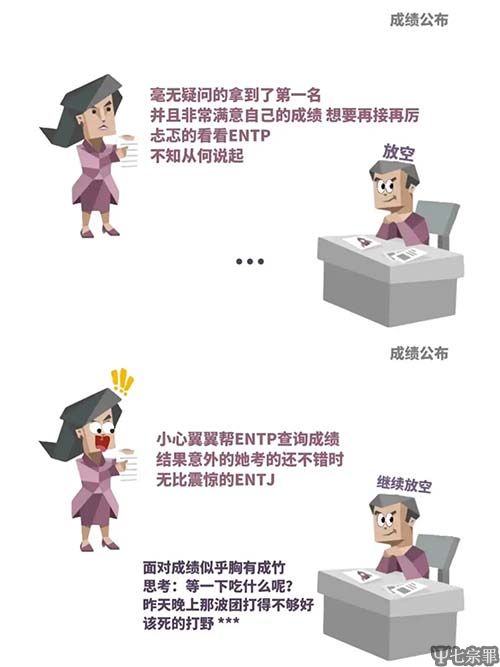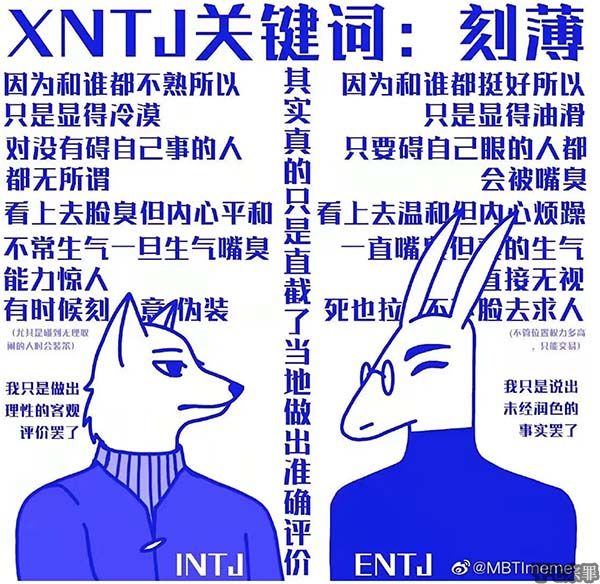ISTP Personality Type Profile
ISTP人格型
“ISTP” is one of sixteen personality types. While some estimates suggest ISTPs comprise only 5% of the general population, my research and experience suggests this type to be more common, perhaps even as high as 8%. Male ISTPs are thought to outnumber ISTP females at a clip of three to one.
ISTP是16种人格型之一,虽然有些评估表明ISTP只占总人口的5%左右,但据个人的经验和调研,这个占比要更大一些,可能达到8%左右,男性ISTP的人数大约是女性ISTP的三倍。
Like the INTP, the ISTP’s dominant function is Introverted Thinking (Ti), which can be associated with high levels of focus, self-discipline, intentionality, independence, and intensity of thought. ISTPs take life rather seriously and use their inner logic to discern the best ways of navigating it. They may, for instance, use Ti to work out their own personal methods for maximizing performance in a particular sport. They love using their Ti to solve practical problems or to optimize functioning. Because of their independence, self-directedness, and competitiveness, ISTPs may excel at nearly anything they set their mind to.
和INTP一样,ISTP的主导功能也是内向思考(Ti),这一功能与高度专注、自律、目标性、独立性及思维强度有关。

ISTP对待生活的态度非常严肃,他们会用自己的内在逻辑(Ti)去甄选最合适的生活方式。比如,他们可能会通过Ti功能,找到一些能够提升自己运动表现的私人方法。
他们喜欢用Ti功能去解决实际问题,使效用最大化。
由于ISTP的独立性、自主性和好胜心,他们几乎能在任何下定决心的事情上表现出色。
Because ISTPs’ Thinking is introverted in its direction (Ti), it often goes unnoticed by outsiders. What others tend to see is ISTPs’ engaging in action (Se) or mixing with people (Fe). ISTPs’ Extraverted Feeling (Fe) can bring a surprising amount of affability and personableness to their outward presentation. ISTPs often present as sincere, genuine, and approachable. Their Fe confers a certain childlike innocence that others may find refreshing.
由于ISTP的Ti功能是一种内向型的功能,它往往容易被外界忽视,外人更容易观察到的是ISTP的行动力(Se)和与人交往时的状态(Fe)。ISTP的外向情感功能(Fe)使他们呈现出非常友好亲切的外在形象。
ISTP看上去往往诚恳,真实,平易近人,外向情感功能(Fe)赋予了他们孩子般的童真感,给人耳目一新的感觉。
Since neither Ti nor Se is a highly verbal function, ISTPs can be persons of few words. Their relationships are often built around shared interests or activities rather than extensive conversation. But since status and reputation are important to their Se and Fe, ISTPs may be far more talkative at work or in public settings than they are at home. In public, they may be fun and outgoing. In private, they may seem more aloof or disengaged, sensing that their intimates cannot provide them the same degree of ego boost they find in the public arena (Fe). This ostensible disparity between their private and public persona may lead their intimates to consider them narcissistic or hypocritical.
ISTP的主导功能(Ti)和辅助功能(Se)都不属于“强语言性”功能,因此ISTP往往也不是话多的人。他们的社交关系通常建立在共同的兴趣或活动上,而不基于大量的交谈。
另一方面,又因为社会地位与公共名声对于Se功能和Fe功能来说很重要,这让ISTP在工作或公开场合中比在家里健谈得多。
在公开场合里,他们也许是有趣且外向的,但私下里,他们又可能很冷漠、很游离(这是因为他们会觉得亲密关系并不能给他们带来像公共场合(Fe)同样程度的自我提升)。
这种公开和私下的差异可能会让他们的亲密对象觉得他们自恋或虚伪。
ISTPs commonly display conventional, sometimes stylish, forms of dress. While their Ti is concerned with functionality and practicality, their Se and Fe are attuned to the trendy and popular. Physically, ISTPs may have either a lanky or muscular build. While athletic engagement often keeps them fit throughout their childhood, their love for food (Se) may lead to problems with weight in adulthood.
ISTP大多时候穿着朴素,偶尔时髦一下,这是因为他们的主导功能(Ti)关注功能性与实用性,而Se功能和Fe功能又追逐时尚与潮流。
ISTP可能身材瘦长,也可能肌肉发达。童年时大量的体育锻炼往往使他们保持苗条的身材,但成年后对美食的热爱(Se)又极有可能造成一些体重方面的问题。
While not to the same extent as their ESTP counterparts, ISTPs are undeterred from investing in high quality and/or high-status goods. Like other Se types, they can appreciate excellent food (some are even foodies) and stylish clothing. Fancy or vintage sports cars, motorcycles, or power tools commonly line the garages of ISTPs.
尽管没有到ESTP那样的程度,但ISTP也确实愿意投资一些高质量、高品质的商品。
和其他Se型人格一样,他们能很好地鉴赏美食(有些甚至成为美食家)和潮流服饰。名贵跑车、老爷车、机动车、各式电动工具都会出现在ISTP的车库中。
Like other SP types, ISTPs often display great kinesthetic intelligence. They are often mechanically-inclined and endowed with excellent hand-eye coordination. In contrast to INTPs, who sport high levels of mental energy, ISTPs may exhibit higher levels of physical energy and stamina. While INTPs use their Ne to explore ideas, the ISTP and ISFP prefer using their hands, body, and other senses to explore and manipulate the concrete world (Se).
和其他SP型人格一样,ISTP通常拥有高水平的“身体动觉智能”,他们往往是机械达人,并拥有出色的手眼协调能力。
与INTP高水平的脑力劳动相比,ISTP表现出更高水平的身体活力与耐力。
当INTP使用他们的Ne功能来探索新的观点想法时,ISTP和ISFP则更喜欢用他们的双手、身体或其他感官来摸索现实世界(Se)。
Because of their preference for hands-on activities, ISTPs may underperform in academic settings. This is typically not due to a lack of ability per se, but a lack of interest or stimulation. As is true for all Sensing types, being forced to deal in abstractions for too long can be draining for ISTPs. Their need for physical activity and impatience with abstractions may also explain why ISTP school children are more likely to be diagnosed with ADD or ADHD than some of the other personality types. ISTP students who can set their focus on a particular career goal or endpoint, such as becoming a surgeon, are apt to fare better.
由于ISTP更喜欢动手实操的活动,他们的学业表现可能不会太好,这不是因为他们缺乏能力,而是因为缺乏兴趣或有效刺激。和所有S型人格一样,如果ISTP被迫长时间地处理一些抽象命题,将会消耗他们巨大的能量。
他们对体力活动的热爱和对抽象概念的兴趣乏乏,都可以解释为什么ISTP型孩童更容易被诊断为“注意力缺失症”或“多动症”。如果ISTP型学生能将注意力集中在一个更具体的职业目标上(比如成为一名外科医生),也许情况会改善很多。
Generally speaking, ISTP career-seekers are wise to pursue careers that allow them to use their practical intelligence to solve concrete problems (i.e., Holland “Realistic” careers). They can make excellent artisans, athletes, mechanics, drummers, maintenance workers, chiropractors, surgeons, pilots, chefs, etc.
总体来说,在职业选择上ISTP应该明智地选择那些需要运用实践能力解决具体问题的岗位(也就是在霍兰德职业量表中被归类于“实操型”的工作)。
ISTP可以成为优秀的工匠、运动员、机械师、鼓手、维修工、按摩师、外科医生、飞行员、厨师等。
While ISTP differ from ISTJs by only one “preference” (i.e., J-P), these types actually share zero functions in common. This makes them far more different than is sometimes recognized. As TJ types, ISTJs are more direct and firm (even blunt) in their assertions than ISTPs are. ISTPs use Fe rather than Te, which confers a certain social ease, even charm, which ISTJs often lack. Moreover, ISTPs use Se rather than Si, making them less concerned with preserving past precedent than ISTJs are. Finally, ISTPs are more inclined toward “hands-on” and Realistic careers, whereas ISTJs gravitate toward “white collar” sorts of work.
尽管ISTP与ISTJ只有最后一个字母“P-J”的区别,但实际上这两种人格的前四种功能类型完全不同,他们之间的差异也比想象中更大。作为TJ型人格,ISTJ在判断时比ISTP更直接、更坚定,也更坦率。
ISTP使用Fe功能而不是Te功能,这让ISTP比ISTJ更具有社交魅力,此外,ISTP使用Se功能而不是Si功能,这也让他们并不像ISTJ那样执着于过往的先例,最后,ISTP更喜欢“实操型”的工作,而ISTJ则更喜欢于“白领类”的工作。
ISTP Personality Development & “Functional Stack”
ISTP的人格发展与功能类型
Each personality type prefers to use four of the eight functions first described by Jung. These four functions comprise a type’s “functional stack.” The relative strength of preference for these four functions is expressed in the following manner: dominant, auxiliary, tertiary, and inferior. ISTPs’ first preference is Ti, followed by Se, Ni and Fe respectively. This is depicted in the arrangement of their functional stack:
每种人格型都倾向于使用荣格所描述的八种功能中的四种。这四个功能组成了一种“人格”的“功能类型”。这四个功能的相对强度以下列方式排序:主导功能、辅助功能、第三功能和第四功能。ISTP的主导功能是Ti,其次是Se,Ni 和Fe功能。以下为具体描述:
ISTPs’ functional stack :
ISTP的功能类型:
Dominant function: Introverted Thinking (Ti)主导功能:内向思考(Ti)
Auxiliary function: Extraverted Sensing (Se)辅助功能:外向感觉(Se)
Tertiary function: Introverted Intuition (Ni)第三功能:内向直觉(Ni)
Inferior function: Extraverted Feeling (Fe)第四功能:外向情感(Fe)
While we will soon discuss each function in greater depth, for now, we will turn to another feature of ISTPs’ personality—their type development. As is true for all types, ISTPs’ type development consists of three general phases. These phases roughly correspond to the ordering of the functional stack, with Ti being the first function to blossom, Se the second, on so on. But as we will see, the inferior function is sort of a special case, summoning ISTPs’ attention at an earlier phase than might otherwise be expected.
虽然我们很快就会开始深入地讨论每一个功能,但是现在,我们先转向ISTP的人格发展阶段。正如所有人格型一样,ISTP的人格发展将经历三个阶段。
这些阶段的发展过程大致与功能类型的排列顺序相对应,Ti将是第一个得到发展的功能,Se是第二个,以此类推。但第四功能Fe的发展比较特殊,它将在较早的阶段引起ISTP的注意。
Phase I (Childhood-20s)
阶段一(孩童期-20S)
This phase is characterized by the emergence and differentiation of ISTPs’ dominant function, Introverted Thinking (Ti). Early in life, ISTPs often use their Ti to focus on one or two pursuits. They may for instance, funnel their Ti energies into mastering video games, tinkering with computers, or learning the best way of shooting a basketball. Since they often apply their Ti to hands-on activities—sports, Legos, drumming, video games, and the like—Phase I ISTPs may also show significant development of their auxiliary function, Extraverted Sensing (Se).
这一阶段是ISTP的主导功能——内向思考(Ti)逐渐出现并显著化的过程。
早年时,ISTP通常会将他们的内向思考(Ti)功能专注于一两个目标上。
例如,将Ti的精力用在电游、耍电脑,或者打篮球上。
又因为ISTP通常会将Ti功能用在实践类的活动上——如体育运动、乐高玩具、击鼓、电游等,因此在这一阶段,ISTP的辅助功能(外向感觉Se)也往往能得到很大的发展。
Since their Ti is a rational Judging function, ISTPs tend to approach life fairly seriously. Even from a relatively young age, they can be self-disciplined and goal-oriented, striving for excellence in whatever they do. They can differ markedly from ESTPs in this regard, whose dominant function (Se) is a Perceiving function, leading Phase I ESTPs to be more open-ended and easygoing. While both types utilize Se and Ti, ESTPs are more concerned with perceiving or experiencing the outside world (Se), while ISTPs are more intentional, focused, and self-directed (Ti).
由于主导功能Ti是一个判断型功能,这使得ISTP对待生活的态度很严肃,即使在年轻时,他们也会表现出很强的自我驱动与目标导向性,在任何感兴趣的领域他们都会力争优秀。
这一点上,ISTP与ESTP有显著的不同,ESTP的主导功能(Se)是一种感知型功能,这让处于第一阶段的ESTP要更加开放和随意。
尽管这两种人格型都擅长使用Se功能和Ti功能,但ESTP会更关注感知或体验外部世界(Se),而ISTP则更有目标性、更专注、更自我导向(Ti)。
Phase II (Late Teens-30s)
阶段二(青春期末-30S)
Once their dominant Ti reaches a certain threshold of strength and dominance, ISTPs’ inferior function, Extraverted Feeling (Fe), enters the picture and begins to play a more influential role. This can be confusing because Fe is not next in line in their functional stack. Its undue influence can be understood as deriving from its bipolar relationship with ISTPs’ dominant Ti.
随着ISTP的主导功能Ti(内向思考)发展到一定的强度和支配地位,第四功能Fe(外向情感)就会开始进入ISTP的视线,并逐渐扮演起更有影响力的角色,这可能会让人困惑,因为在功能排序中,第四功能Fe并不是下一个就首当其冲待开发的功能,第四功能Fe的巨大影响可以理解为其与主导功能Ti之间的两级关系。
Phase II ISTPs also show increasing use and development of their auxiliary function, Extraverted Sensing (Se). This may involve exploring new hobbies and interests, such as gourmet cooking. As a Perceiving function, Se also leads to an opening of their Ti judgments to see if they pass the test of lived experience. Since Se is an extraverted and expansive function, Phase II ISTPs may feel it necessary to explore a wide range of experiences before arriving at confident conclusions.
第二阶段的ISTP也会越来越多地开发和使用他们的辅助功能——Se(外向感觉),包括探索新的兴趣爱好,比如美食烹饪。
而作为感知型功能,Se也会帮助主导功能Ti的判断更加开放——让Ti的价值判断接受生活实践的检验。
由于Se是一种外向的、开放型功能,处于阶段二的ISTP可能会逐渐意识到在得出确定的结论之前先探索广泛的经验是很有必要的。
Phase II ISTPs may also begin to tap into their tertiary function, Introverted Intuition (Ni), which can subconsciously assist ISTPs in piecing together their Se experiences, further clarifying their identity and worldview.
第二阶段的ISTP也可能开始发展他们的第三功能——内向直觉(Ni),这将在无意识中帮助ISTP将Se的生活体验整合为一个更清晰的认知观及世界观。
Phase III (30s, 40s, & Beyond)
阶段三(30s,40s,及以后)
If all goes well and they are fortunate enough to enter Phase III, ISTPs become increasingly aware of the insidious ways of their inferior Fe. As they become more aware of their inferior and learn to function more authentically as ISTPs, they can experience greater balance between their Ti and Fe. This will be elaborated later in this profile.
如果一切顺利并幸运地进入到人格发展的第三阶段,ISTP会越来越知觉到他们第四功能Fe的隐秘存在感,而随着对Fe的知觉,他们会越来越像一个成熟的ISTP那样健康地使用各项功能,他们会在Ti和Fe之间感受到更好的平衡,这将在后文中详述。
ISTPs’ Dominant Function: Introverted Thinking (Ti)
ISTP的主导功能:内向思考(Ti)
To understand ISTPs, or other IP types, it is necessary to recognize the full implications of their dominant function being a Judging function. I discuss this issue in my post, Rethinking Judging and Perceiving in Introverts. In short, I suggest that ISTPs are best viewed as predominant Judgers and display many characteristics of EJs, only that these behaviors are directed inwardly or toward themselves.
要很好地理解ISTP或其他IP型人格,必须要充分地认识到他们的主导功能是一种判断型功能(Ti or Fi)。
简单来说,ISTP应该被视为判断主导型人格,他们拥有众多和EJ型人格(主导功能为Te or Fe)一样的特性,只是IP型人格的行为更加内化、更自我导向。
Ti involves the use of logic and reason for the sake of understanding a given problem, situation, or system. ISTPs use Ti to solve problems, to optimize functioning, and to bring structure and order to their inner world. This inner structuring grants them a strong sense of inner control. It allows ISTPs to be inwardly self-disciplined and to independently manage their lives and personal projects.
Ti功能是指在面对任何问题、情境、体系时,都运用逻辑与理性去处理,ISTP使用Ti功能来解决问题、优化效用,也为其内在世界建立架构与秩序,这种内在架构能为ISTP带来强烈的自我控制感,也能使ISTP高度自律、高度自立地管理好自己的生活和个人计划。
The disciplined nature of Ti may inspire ISTPs to frame their lives in terms of personal challenges or a series of independent projects. While not shying away from competing with others, ISTPs enjoy taking on challenges and projects for the mere pleasure of it. Such challenges may be physical (e.g., trying to achieve an optimal level of fitness), practical (e.g., fixing a car), creative (e.g., craftsmanship), or interpersonal.
Ti训练有素的特性可能会激励ISTP将生活视为自我的挑战或一系列独立的目标。他们非常享受这种“将人生视为自我的挑战”所带来的纯粹幸福感。
这些挑战可能是体能上的(比如达到最佳健身状态)、也可能是实操性的(比如修车)、创造性的(具体技艺)、或者人际关系导向的。
At times, the inwardly focused and intentional nature of Ti lead can lead ISTPs to mistype themselves as ISTJs. In so doing, they rightly recognize their inner Judging nature, but wrongly conclude that they must be a J-type. They fail to recognize that the J-P label refers only to outward demeanor and behavior. This may partly explain what I see as the underrepresentation of ISTPs in demographic data.
有时候,Ti的内向性和目的性会让ISTP误认为自己是ISTJ。这种误判正确地意识到了ISTP是由“内向判断功能(Ti)”所主导的本质,但却错误地以为“内向判断”就必须是J型人格,他们没有意识到J-P维度仅仅指向外在行为和举止。
这种误判也部分解释了我所观察到的ISTP人数报告不足的情况。
Ti might also be viewed in terms of fluid intelligence, whereas Extraverted Thinking (Te) seems more related to crystallized intelligence. Ti is more intuitive, contextual, and right-brained, whereas Te is more procedure-oriented and left-brained. The fluid nature of their Ti, combined with the keen observational powers of their Se, contributes to ISTPs’ acumen as practical problem solvers. ISTPs can analyze a situation, discern how things should work, and then determine how to fix it. While a Te type might feel compelled to use schematics or manuals to diagnose the problem, ISTPs rely on their Ti’s ability to reason their way through concrete problems, even those they’ve never encountered. This contributes to their skill as mechanics, maintenance workers, machinists, surgeons, technicians, etc.
Ti可以理解为“流体智力”,Te则和“固体智力”相关。Ti更具有直觉性、情境性,为右脑导向,而Te则倾向于过程性,为左脑导向。Ti的流动性与Se的敏锐观察力一起使ISTP成为了优秀的问题解决者。
ISTP懂得如何分析情况,如何判断事物的发展,如何最终解决它。Te型人格可能还得依赖于原理或指导手册来解决问题,而ISTP则直接依赖于他们的Ti去判断问题,哪怕是从未遇到过的问题。
这些特征都促使ISTP成为优秀的机械师、维修工人、外科医生、技术员等。
ISTPs’ Auxiliary Function: Extraverted Sensing (Se)
ISTP的辅助功能:外向感觉(Se)
Introverted Sensing (Si) is conservative with respect to new sensations and the material world. Extraverted Sensing (Se), by contrast, is more materially liberal and novelty-oriented. Se types (especially ESPs) often exhibit a laissez-faire, “eat, drink, and be merry” approach to life.
内向感觉(Si)是一种在感官和物质方面趋于保守的功能,与此相反,外向感觉(Se)则是一种追逐物质享乐与新鲜刺激的功能。
Se型人格(尤其是ESP型人格)通常表现出一种自由放纵的“吃、喝、玩、乐”式生活态度。
Unlike Si, Se is not content with routine and familiar experiences. For this reason, ISTPs enjoy physical thrills and new sensations. Their Ti penchant for challenges, combined with the physically active and explorative nature of their Se, makes ISTPs solid candidates for sports and physical challenges. While their inferior Fe may like the camaraderie associated with team sports, ISTPs may also enjoy the individual challenge of activities like cycling or long-distance running.
与Si不同,Se不满足于重复过往的经验,因此,ISTP会很喜欢寻求身体的刺激和新奇的体验。主导功能Ti对“挑战”的偏爱,加上辅助功能Se对体育活动的探索欲,使ISTP成为了各种体育运动的种子选手。
受第四功能Fe的影响,他们可能会喜欢团体项目所特有的同袍情谊,但像自行车或长跑这样的个人挑战项目,他们也会很喜欢。
Se also attunes to the concrete details and sensory information of the environment by way of the five senses. SP types scan the environment for interesting sensory novelties, noticing details in the environment that other types might readily gloss over. This is why SPs (especially ESPs) often have strong visual recall, or what is sometimes dubbed a “photographic” memory. ISTPs may utilize their Se’s attention to detail in any number of ways.
Se通过具体的五官五感去收集现实世界的信息。SP型人格往往能在外界环境中发现新奇有趣的事物,留意到很多其他人可能会忽略的细节,他们通常拥有出众的视觉记忆力,或者说“过目不忘”的能力。
ISTP可以用各种方式来开发他们Se功能对细节的关注。
ISTPs also employ their Se in their daily work as mechanics, technicians, chefs, construction workers, etc. They make excellent craftsmen, using their Se to attend to the finest physical details. They love working with their hands and using tools to produce high quality pieces.
ISTP也会在日常工作中使用他们的Se功能,如机械师,技术员,厨师,建筑工人等工作。
ISTP是杰出的工匠,他们通过Se功能来打磨最精细的细节,他们喜欢动手的工作,善于使用工具打造出高质量的作品。
Unlike the Ne-Si function pair, which encourages makeshift tool use (Ne) in the name of material conservation (Si), the Se-Ni function pair impels ISTPs to acquire the right tools in order to do the job the “right way.” In this vein, ISTPs are not opposed to spending a little extra on high quality tools, parts, etc.
不像“Ne-Si”功能配对(ENP型人格),往往会以“节约 (Si)”的名义鼓励使用一些临时性的工具(Ne) ,“Se-Ni”的功能配对会让ISTP认为“需要使用合适的工具去做适当的事情”。
因此ISTP并不介意在购买工具、零配件上多花些钱。
Se also differs from Ne in that it is not a highly verbal or abstract function. So while INTPs enjoy sitting around discussing ideas, ISTPs would often prefer to be “doing” something. Even watching sports can be more stimulating than conversation for ISTPs, since it stimulates their Se and allows them to vicariously participate in the action.
Se与Ne的不同之处在于,它并不是一个高度语言性或抽象性的功能。因此,当INTP喜欢坐在一起讨论想法时,ISTP往往更喜欢一起“做”点什么。对ISTP来说,即使是观看体育赛事也比坐着聊天来得更刺激,因为这能激发他们的Se,让他们间接地参与到比赛中来。
ISTPs’ Tertiary Function: Introverted Intuition (Ni)
ISTP的第三功能:内向直觉(Ni)
ISTPs’ tertiary function is Introverted Intuition (Ni). In combination with their dominant Ti, ISTPs may display some degree of interest in abstract or theoretical topics. After all, Ni and Ti are the same two introverted functions employed by INFJs, who are among the most theoretical-minded of all types. However, because ISTPs’ Ni is more unconscious, it is less accessible to them for immediate intuitive perception. Therefore, like other SP types, ISTPs are more likely to gain insight through analyzing a breadth of life experiences (Ti-Se). Ni can also aid in the process, helping ISTPs synthesize and extract meaning from a breadth of Se experiences.
ISTP的第三功能为内向直觉(Ni),与主导功能(Ti)一起,能让ISTP对一些抽象命题发展出兴趣。毕竟Ni和Ti正是INFJ所使用的两种内向型功能,而INFJ又是最具理论头脑的人格型之一。
然而,ISTP的Ni作为第三功能,比起真正深层次的直觉感知来说还是差得远。
就如其他SP型人格一样,ISTP大部分的洞察还是通过拓宽生活阅历(Ti-Se)获得的,Ni只是在这个过程中提供一定的帮助,帮助ISTP整合并提取Se所带来的广泛经验。
ISTPs’ Inferior Function: Extraverted Feeling (Fe)
ISTP的第四功能:外向情感(Fe)
Like other types, ISTPs can be easily blinded to the degree to which their inferior function impacts their decisions and behavior. Without sufficiently understanding the inferior function, Extraverted Feeling (Fe), ISTPs will continue to feel incomplete and be prone to unhealthy decision-making in their careers, lifestyle, and relationships.
和其他人格型一样,ISTP也容易忽视掉他们的第四功能——外向情感(Fe),直到这已经影响到他们的行为和决策。
如果没有足够意识并发展他们的第四功能, ISTP将会持续地感觉到生命的不完整,也将极有可能在职业选择和人际关系中做出不明智的决定。
The ISTP’s personality type dynamics can be largely understood as an attempt find a balance between Ti and Fe, independence (Ti) and interdependence (Fe), self (Ti) and others (Fe). Since Ti and Fe comprise a functional whole, ISTPs intuitively realize that they need to better integrate their Fe in order to feel more whole and complete.
ISTP的人格稳态可以理解为在Ti和Fe之间寻找到某种平衡(这是独立性Ti与依赖感Fe之间的平衡,也是自我Ti与他人Fe之间的平衡),ISTP会越来越直观地意识到,只有更好地发展起Fe功能,才能感受到人生的完整与统一。
Obsessiveness / Workaholism
强迫症 / 工作狂
“In the grip” of the inferior function, all personality types are prone to acting compulsively and obsessively. Grip experiences can be difficult to escape, since the less conscious self (i.e., the inferior function) takes over as the driver of the personality. While the content of grip experiences may differ across the types, their basic shape is essentially the same.
受第四功能的“绑架”,很多人格型都会呈现出一些“强迫症”特征。这种“强迫症”往往很难改变,因为它是受到四种功能类型中最为无意识的功能(第四功能)所驱使的。
虽然不同人格型所体验到的“强迫症”表现有所不同,但它们的本质是相同的。
For ISTPs (and INTPs), being in the grip often involves workaholism. As T dominants, work (including personal projects and hobbies), comprises a central component of ISTPs’ identity. In doing what they enjoy, ISTPs are naturally very disciplined and thorough. When they are in the grip, however, they become obsessive, perfectionistic, and unable to let go of whatever they are doing. During such times, ISTPs may alienate themselves from others, insisting they need more and more time to themselves (this is why ISTPs often test as Enneagram Fives). They become trapped, functioning only in Judging mode (Ti-Fe), while forgoing the Perceiving functions (Se-Ni) in the middle of their functional stack.
对于ISTP((和INTP)来说,强迫症往往表现为“工作狂”。作为T型人格,工作(包括个人的事业及爱好)的确是ISTP自我认同的核心组成部分。
当他们做着自己喜欢的事时,ISTP是非常自律且投入的。然而,一旦他们由此进入到“强迫症”状态,他们会变得偏执、完美主义,对任何事都无法放手,在这种状态下,他们甚至可能会疏远他人,觉得要把更多的时间留给自己(这也是为什么ISTP的九型人格测试结果通常为第五型)。
当ISTP陷入到“强迫症”状态时,就只剩下判断型功能(Ti-Fe)在工作,而感知型功能(Se-Ni)则被完全遗弃了。
As for all types, the process of slipping into grip experiences is often subtle and insidious. For instance, ISTPs may have a goal in mind for what they want to accomplish that day, only to discover the task much larger than they originally imagined. But because a bigger task poses a greater challenge, they take the bait and see if they can still manage to get it done. The problem, of course, is that this essentially locks them into Judging mode, since any deviation into Se Perceiving will preclude them from accomplishing their goal. This includes closing themselves off to other people, who come to be viewed as intrusions or impediments to their productivity. Consequently, ISTPs who are frequently in the grip may end up ostracizing themselves from other people.
对于所有人格型来说,陷入到这种偏执状态的过程都是微妙而危险的。比如,ISTP可能设想了他一天中想要完成的目标,结果却发现任务比他最初预想的大得多。
但又因为更大的任务往往会带来更大的挑战,他便会立马“上钩”,一定要看看自己能否办得成这件事。这种行为模式所导致的最大问题是,它会将ISTP锁死在判断状态(Ti)中,因为此时任何感知上(Se)的偏差都将可能会阻碍他们实现目标,于是,他们极有可能把所有人都拒之门外,并把这些人看作是实现目标的干涉者和阻碍者。
陷入偏执状态的ISTP最终会把自己孤立起来。
What is interesting is that ISTPs, like other types, can be relatively unaware of falling into a grip experience, rationalizing their obsessiveness as being “efficient” or “productive.” Moreover, since grip experiences are fueled by adrenaline, they can feel “good” at some level, allowing for heightened focus and endurance. At the same time, there is a part of ISTPs that knows they are in trouble. When all they can do is compulsively hurl themselves into their work, a part of them realizes this is unsustainable, unbalanced, and potentially destructive.
有趣的是,ISTP和其他人格型一样,可能并无法意识到自己陷入了偏执状态,还会将自己的“强迫症”合理化为“高效率”或“高产出”的必要途径。而且,由于这种“强迫症”受到肾上腺素的驱动,某种程度上他们会感觉“相当良好”,从而提升注意力和忍耐度。
但与此同时,他们还有小部分清醒的意识知道自己遇上了麻烦。当他们不得不强迫自己全身心地投入到工作中时,他们另一部分意识也感知到这种状态是不可持续的、不均衡的,是有潜在危险性的。
To compensate for the isolation involved with grip behavior, ISTPs may “crutch” their inferior Fe through their relationships, which provides the reassurance that external Fe support is available should they need it. This is why so many ISTPs (and INTPs) struggle when it comes to balancing their work and interpersonal relationships.
为了把自己从偏执的孤立状态中解救出来,ISTP需要仰仗他们的第四功能Fe所构建的人际关系,Fe为ISTP提供了必不可少的外部支持。这也是众多ISTP(和INTP)都会在平衡工作与人际关系上遇到困难的原因。
Slippery & Elusive Emotions
捉摸不定的情绪
For ISTPs and INTPs alike, their Fe is rather naive and childlike. They may be easily moved by cheesy romantic comedies or sappy love songs, anything that incites their subconscious Fe emotions. They can also be easy targets for “love at first sight” sorts of infatuation. They may be particularly susceptible to being wooed by Feeling types (especially FJs), who can bypass their typical channels of logic and appeal directly to ISTPs’ less conscious Fe.
对于ISTP和INTP来说,他们的Fe功能会呈现出相当幼稚或孩子气的一面,他们可能会很容易被一些套路的浪漫喜剧、伤心情歌所打动,或者是其他任何无意中激发出他们Fe功能的东西。
他们也很容易一见钟情,容易被F型人格(尤其是FJ型)所吸引,因为F型人格会绕过他们的逻辑理性区,直接对他们“最弱的功能Fe”产生吸引力。
Because of the inferior position of their Fe, ISTPs struggle to intentionally contact or understand their emotions. It’s not they never experience emotions, but only that their emotions seem to have a mind of their own, coming and going as they please. So even if ISTPs are aware of what emotions are appropriate for a given situation, they often do not “feel” them at the time, engendering a sense of awkwardness or discomfort in emotional situations. They may even experience the desired emotion a few hours later, but it’s almost as though their emotions get “stage fright” when “put on the spot.” To compensate, ISTPs may try to use their Fe to offer the socially-appropriate words. But without experiencing the emotions directly, they often sound clumsy or contrived in their expressions. At times, this can be difficult for their romantic partners, particularly for FJ types, who desire a reciprocation of authentic emotional expression. But because of their Fe stage fright, ISTPs may not experience their feelings “at the right times” or can have trouble expressing them when they are present.
由于Fe功能排序靠后,ISTP往往感觉很难捕捉或者理解自己的情绪,这并不是说他们从来没有过情绪体验,只是他们的情绪似乎来来去去,不受控制。
因此,即使有时候他们知道在特定情况下什么样的情绪是合适的,他们也通常不会在当下感知到,反而会觉得尴尬或不适。
他们甚至可能会在几小时后才后知后觉地体验到应有的情绪,但当“聚光灯打在他们头上时”,他们通常是“怯场”的。为了弥补这一点,ISTP可能会使用Fe来进行适当的社交回应,但由于他们并没有直接的情绪体验,所以在表达上还是会显得笨拙或呆板。
对于ISTP的伴侣来说这可能是一个考验,尤其是对于那些FJ型的伴侣,因为FJ型人格往往渴望真正的情感交流,由于ISTP的Fe功能常常“怯场”,他们很难“在合适的时间”唤起与当下情境相适宜的情绪,或者很难当场表达出来。
While ISTPs can certainly have trouble contacting their emotions, they usually have little difficulty overriding or detaching from them. Consequently, ISTPs are less apt to struggle with guilt, regret, or shame in the way that other types might. Others may even be surprised how quickly ISTPs can resume “business as usual” after what most would consider tragic or traumatic circumstances. This should not necessarily be viewed as a flaw in the ISTP, however, but merely a reflection of the unconscious nature of their Fe.
尽管ISTP确实很难捕捉到自己的情绪,但他们也同样能很轻易地摆脱掉这些情绪。因此,ISTP不太会经历那些其他人格型在内疚感、惭愧感和羞耻感方面的挣扎。
很多人都惊讶于ISTP在一些大型悲剧或创伤性事件后的复原能力——他们似乎立刻就能“一切如常”。然而,这不应该被视为ISTP的缺陷,这仅仅是他们的Fe作为排序最后(最无意识)的功能的一种真实反映。
Conflict-Avoidance & Desire for Affirmation
避免冲突 & 渴望认可
ISTPs’ want everyone to feel included and to be treated with fairness and respect (Fe). While not as warm or effusive as FJ types, ISTPs are concerned with others’ feelings and try to avoid hurting or offending them. Like FJ types, they seek to maintain a basic level of harmony in their immediate circumstances.
ISTP希望每个人都能被接纳,感受到公平和尊重(Fe)。尽管他们并不像FJ型人格那样看上去又暖又热情,但他们也会很关心他人的感受,尽量避免伤害或冒犯到别人。
像FJ类型人格一样,他们寻求保持氛围的和谐。
Fe also contributes to ISTPs’ desire for public affirmation. Fe involves making connections between one’s own emotions and those of others. While ISTPs may not always “feel” what others are feeling, their Fe still desires the sense of social affirmation and validation. Consequently, there are times when ISTPs are helpful or compliant largely for the sake of external approval or to maintain a certain public perception. ISTPs with a strong concern for their image can take social engagements quite seriously. They want others to see them as laudable employees, spouses, parents, or citizens. Their desire for public esteem can also be a motivating force in ISTPs’ desire for achievement (This is why ISTPs may also score high as Enneagram Threes).
Fe也促进了ISTP对外界认可的渴望,Fe是一个能把个人的情感与他人的情感连接起来的功能,尽管ISTP确实很难在情感层面与他人建立起联结,但他们的Fe仍然渴望着社会的欣赏与肯定。
因此,有时候ISTP会看上去很温顺且乐于助人,这是因为他们想获得外界的认可。注重自己形象的ISTP也会非常认真地对待社交活动,他们希望被看作是值得称赞的员工、伴侣、父母或公民。
这些对外界认可的渴望也成为了ISTP渴望成功的动力(这也是为什么很多ISTP在九型人格的第三型上得分较高)。
ISTPs’ propensity for conflict-avoidance and need for affirmation, on the one hand, with their need for independence (Ti), on the other, contributes to no small number of relational difficulties. Especially when in the grip of workaholism, ISTPs may feel they don’t need or want other people around. Eventually, they come to a point of feeling miserably imbalanced, which prompts them to reinitiate contact with others, at least until they fall into the grip again. This cycle of alternating between needing and devaluing others is common among ISTPs and narcissists alike.
一方面,ISTP避免冲突、渴望他人的肯定(Fe),但另一方面,他们又很需要独立的空间(Ti),这就导致了大量的矛盾冲突。
当他们被“工作狂”的状态所占据时,会觉得自己并不需要其他人,但最终他们又会痛苦地感觉到失衡,从而促使他们重新开始与别人接触,直到又再一次陷入到“工作狂”的状态。
在ISTP和一些自恋型人格中,这种“渴望他人”又“疏远他人”的交替循环很常见。
In the name of conflict-avoidance and preservation of external harmony, ISTPs may do all they can to circumvent directly expressing their frustrations or grievances. Wittingly or not, they view conflict as a potential threat to the relationship they depend on to meet their Fe needs, as well as a threat to the flawless image they seek to preserve. So rather than giving voice (Fe) to their concerns, ISTPs are more apt to analyze (Ti) or act on them (Se), often in passive-aggressive ways. They may, for instance, intentionally start spending more time at the office as a passive form of rebellion against their partner. Or, they may make sudden executive decisions without giving others any say or prior notice. Poor communication can also lead ISTPs to create a convoluted set of assumptions about what their partners think, want, and expect. Unhealthy ISTPs may spin an ever-expanding web of faulty beliefs and assumptions about their partner. In so doing, they often come to resent or otherwise think negatively of their mates, even if largely a product of their own faulty conclusions.
出于“避免冲突和维护和谐”的目的,ISTP会尽其所能地避免直接表达沮丧或不满。在Fe功能的影响下,他们总是有意或无意地把“冲突”看作是维系关系、保持自己完美形象的潜在威胁。
因此,比起坦率地表达自己的担忧(Fe),ISTP更倾向于默默地分析(Ti)、独自采取行动(Se)——通常呈现出“消极攻击”的形式。比如,他们可能会故意加班,作为对伴侣的消极反抗,又比如,他们可能在没有任何事先沟通的情况下做出突然的行为决定。
不顺畅的沟通也可能会导致ISTP对他们伴侣的想法、期望产生一系列复杂的设想,一些心理失衡的ISTP甚至会不断扩大他们对伴侣的错误认知和观念。
在这一过程中,他们会越来越消极或怨恨地看待自己的伴侣,即使这在很大程度上是他们自己错误设想的产物。
Personal Growth for ISTPs
ISTP的个人成长
Personal growth for ISTPs involves integrating their Fe through consistent and satisfying use of their Ti and Se. Integrating ISTPs must also must learn to recognize the difference between healthy modes of work versus functioning in the grip of their inferior function. Healthy work for ISTPs includes remaining open to Se experiences and diversions, which can keep them from becoming too one-track minded.
ISTP的个人成长需要不断地使用Ti功能和Se功能来整合他们的Fe功能。成熟的ISTP必须学会区分健康的工作状态和偏执的“工作狂”状态之间的差异。
对ISTP来说,健康的工作状态需要对Se的感知体验保持开放的心态,这能防止ISTP变得过于狭隘。
In addition to taking a healthier approach to their work, integrating ISTPs must enhance their self-awareness and communication in their relationships. This includes working to unearth all their implicit assumptions about relationships in general and their partner in particular. It means being willing to dialogue about uncomfortable topics that may produce temporary pain or conflict. It is not until they “clear the air,” learning to be more open and honest with themselves and their partners, that ISTPs will experience true satisfaction and wholeness in their relationships.
除了采取更健康的工作方式,成熟的ISTP必须增强他们的自我认知,增加在人际关系中的交流与沟通,这意味着他们要敢于直面并挖掘自己在所有人际关系中的隐含假设与心理模式(尤其是在与伴侣的关系中),也就是意味着他们要敢于就那些可能会在短时间内产生痛苦与冲突的话题进行沟通。
只有当他们敢于“澄清事实”、对自己和伴侣都敞开心胸、坦诚面对时,ISTP才能最终在这段关系中体验真正的完整与满足。
机翻系列:
1、ISFJ守护者型-在思想和行为上都非常执着于过去 (机翻)
2、ENFJ教育家型-是热情的、迷人的、有魅力的、有说服力的、健谈的一类人 机翻
3、INFP哲学家型-富有创造力的探索者,喜欢随性生活的人生 机翻
4、交际花ENFP-我不感兴趣你靠什么为生,我只想知道你内心渴望什么(一) (机翻,关键字:自由)
5、交际花ENFP-我不感兴趣你靠什么为生,我只想知道你内心渴望什么(二) (机翻)
6、INTP思考者-所有人格中独立且最具哲理性的人格型 机翻
7、物流师ISTJ-喜欢定义好的规则,却不愿意改变规则或尝试新事物 (机翻)
8、ENTJ元帅型-最容易相信我们是自己命运的主宰者 机翻
9、老灵魂INFJ-凡被给予的人,都将被要求;凡被委以重任的人,会有更多的要求 机翻
10、INTJ是N型人格中内耗非常小的一种人格型,也因为内耗小,他们得以全力以赴地去做好自己钟情的事业,而不用在内耗中损伤精力。 (机翻)
11、ESTJ执行官-任何值得信赖的人都会坚持他们认为正确的事情… (机翻)
12、ENTP发明家型-多才多艺、永不满足的他,总是在探索新想法,寻找可能性 (机翻)
 七宗罪心理
七宗罪心理













